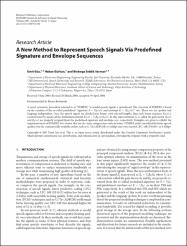A new method to represent speech signals via predefined signature and envelope sequences
Citation
Güz, Ü., Gürkan, H. & Yarman, B. S. B. (2007). A new method to represent speech signals via predefined signature and envelope sequences. Eurasip Journal on Advances in Signal Processing, 2007, 1-17. doi:10.1155/2007/56382Abstract
A novel systematic procedure referred to as "SYMPES" to model speech signals is introduced. The structure of SYMPES is based on the creation of the so-called predefined "signature S = {S(R)(n)} and envelope E = {E(K) (n)}" sets. These sets are speaker and language independent. Once the speech signals are divided into frames with selected lengths, then each frame sequence X(i)( n) is reconstructed by means of the mathematical form X(i)( n) = C(i)E(K) (n) S(R)(n). In this representation, C(i) is called the gain factor, S(R)(n) and E(K) (n) are properly assigned from the predefined signature and envelope sets, respectively. Examples are given to exhibit the implementation of SYMPES. It is shown that for the same compression ratio or better, SYMPES yields considerably better speech quality over the commercially available coders such as G. 726 (ADPCM) at 16 kbps and voice excited LPC-10E (FS1015) at 2.4 kbps.


















